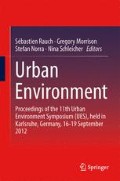Abstract
Road run off typically contains a variety of contaminants such as metals and road salt. Odonata larvae are important members in a variety of freshwater ecosystems which may receive road runoff. The objective of the present work was to investigate the uptake and excretion kinetics of cadmium (Cd), cobalt (Co) and antimony (Sb) in odonata larvae using radioactive tracer technique, and secondly how addition of road salt would affect the uptake. Larvae were individually exposed in beakers containing sediment spiked with 109Cd, 60Co and 125Sb and water with different concentrations of road salt. The results showed that at higher salt concentrations more 109Cd and 60Co were mobilized from the sediments, however, the uptake in the larvae decreased. Antimony-125 was strongly bound in the sediment, and addition of salt did not affect the accumulation in the larvae significantly.
Access this chapter
Tax calculation will be finalised at checkout
Purchases are for personal use only
References
Carvalho PCS, Neiva AMR, Silva M (2009) Geochemistry of soils, stream sediments and waters close to abandoned W-Au-Sb mines at Sarzedas, Castelo Branco, central Portugal. Geochem-Explor Environ Anal 9(4):341–352. doi:10.1144/1467-7873/09-208
Clubb RW, Gaufin AR, Lords JL (1975) Acute cadmium toxicity studies upon 9 species of species of aquatic insects. Environ Res 9(3):332–341. doi:10.1016/0013-9351(75)90013-4
Culioli J-L, Fouquoire A, Calendini S, Mori C, Orsini A (2009) Trophic transfer of arsenic and antimony in a freshwater ecosystem: a field study. Aquatic Toxicol 94(4):286–293. doi:10.1016/j.aquatox.2009.07.016
Duran M, Kara Y, Akyildiz GK, Ozdemir A (2007) Antimony and heavy metals accumulation in some macroinvertebrates in the Yesilirmak River (N Turkey) near the sb-mining area. Bull Environ Contam Toxicol 78(5):395–399. doi:10.1007/s00128-007-9183-x
Hare L (1992) Aquatic insects and trace-metals—bioavailability, bioaccumulation, and toxicity. Crit Rev Toxicol 22(5–6):327–369
Meland S (2010) Ecotoxicological effects of highway and tunnel wash water runoff. Norwegian University of Life Sciences, Ås
Meyer W, Harisch G, Sagredos AN (1986) Biochemical and histochemical aspects of lead exposure in dragonfly larvae (Odonata Anisoptera). Ecotoxicol Environ Saf 11(3):308–319. doi:10.1016/0147-6513(86)90104-1
Oughton DH, Salbu B, Riise G, Lien H, Ostby G, Noren A (1992) Radionuclide mobility and bioavailability in Norwegian and Soviet soils. Analyst 117(3):481–486. doi:10.1039/an9921700481
Shuhaimi-Othman M, Pascoe D (2007) Bioconcentration and depurationof of copper, cadmium, and zinc mixtures by the freshwater amphipod Hyalella azteca. Ecotoxicol Environ Saf 66(1):29–35. doi:10.1016/j.ecoenv.2006.03.003
Tessier A, Campbell PGC, Bisson M (1979) Sequential extraction procedure for the speciation of particulate trace-metals. Anal Chem 51(7):844–851. doi:10.1021/ac50043a017
Tollett VD, Benvenutti EL, Deer LA, Rice TM (2009) Differential toxicity to Cd, Pb, and Cu in dragonfly larvae (Insecta: Odonata). Arch Environ Contam Toxicol 56(1):77–84. doi:10.1007/s00244-008-9170-1
van Hattum B, van Straalen NM, Govers HAJ (1996) Trace metals in populations of freshwater isopods: influence of biotic and abiotic variables. Arch Environ Cont Toxicol 31(3):303–318
Wright DA (1995) Trace-metal and major ion interactions in aquatic animals. Marine Pollut Bull 31(1–3):8–18. doi:10.1016/0025-326x(95)00036-m
Acknowledgments
This work was financed by the Norwegian Public Roads Administration. We thank Cato Wendel for assistance on autoradiography.
Author information
Authors and Affiliations
Corresponding author
Editor information
Editors and Affiliations
Rights and permissions
Copyright information
© 2013 Springer Science+Business Media Dordrecht
About this paper
Cite this paper
Heier, L., Nyheim, M., Skipperud, L., Meland, S. (2013). Mobility and Uptake of Antimony, Cadmium and Cobalt in Dragonfly Larvae (Odonata, Anisoptera) as a Function of Road Salt Concentrations—a Tracer Experiment. In: Rauch, S., Morrison, G., Norra, S., Schleicher, N. (eds) Urban Environment. Springer, Dordrecht. https://doi.org/10.1007/978-94-007-7756-9_45
Download citation
DOI: https://doi.org/10.1007/978-94-007-7756-9_45
Published:
Publisher Name: Springer, Dordrecht
Print ISBN: 978-94-007-7755-2
Online ISBN: 978-94-007-7756-9
eBook Packages: EnergyEnergy (R0)

